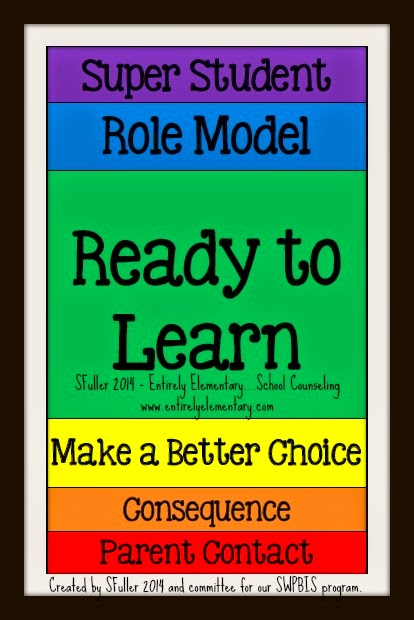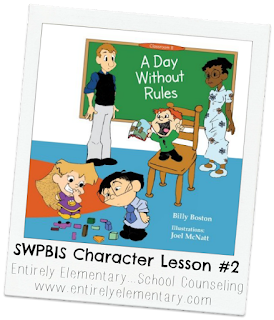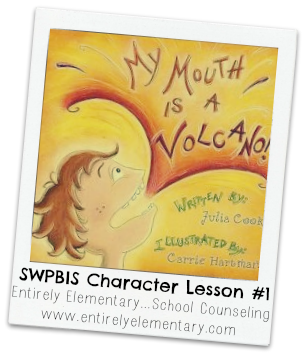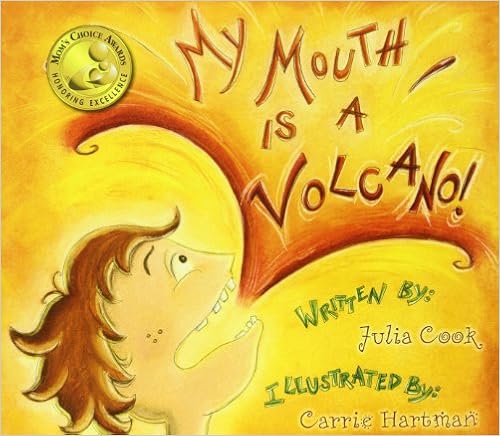I'm frequently asked about strategies for behavioral interventions for students. I have a lot of practice in this and I do share some ideas. However, the biggest learning over the course of my career has been to do whatever I can to be pro-active and preventative. Often as school counselors we are putting out fires until the problems pop back up again (in essence servicing a few). I've had to make a shift in my thinking from constant fire smoldering to putting a lot of time and energy into servicing all students -- school counseling core curriculum -- teaching skills! The school counseling core curriculum, in addition to, our school's Social Emotional Learning Curriculum (PATHS and Olweus) and our SWPBIS (School-Wide Positive Behavior Interventions and Supports) program has lead to school-wide common language/behavioral expectations and a more systematic/data driven way of intervening with students - individually, in SWPBIS Tier II intervention groups, and small support groups. In this second year of implementation, as a committee and as a staff, we are still learning. Side note: the fires will always be there...but all of the other programs in place give a bit of a framework to teach and/or re-teach the needed skills these kiddos are seeking.

My post, SWPBIS How To! Year of Preparation, explained all that went into the year-long planning for our School-Wide Positive Behavior Interventions and Supports Plan. Our committee put in a lot of time and effort into coming up with a program that made the most sense for our school. Check it out if you are thinking about getting one started in your building. This post is going to focus on the actual SWPBIS Plan that we developed. I've decided to write about SWPBIS - primarily because of the amount of questions I'm asked via the blog and Facebook page regarding behavioral interventions, but also because this is a school-wide effort that is making an impact on our student's behavioral choices and ultimately their performance in the classroom. It is my hope that you will take a little something from our learnings.
The Program - Part 1
1. School Rules
During our initial SWPBIS Commitee meetings, we spent a whole lot of time hashing out our school rules. Coming up with the 3 main school rules was the easy part: Be Respectful. Be Responsible. Be Safe. But, developing the expectations for each of those rules was the challenging part. Wording meant all the difference.The expectations needed to be specific and concise. They also had to describe the most important positive behavior that we were looking for in each location.
We wrote expectations for each of the 3 main school rules in the following school areas: Classroom, Hallway and Stairwell, Bathroom, Cafeteria, Playground and the Bus. Below is an example what we decided on for our Hallway and Stairwell expectations. We did our best to write all expectations in a positive voice (although for some that just didn't work).
Hallway and Stairwell
|
· Walk silently in line; don’t
disturb other classes
· STOP, LOOK & LISTEN when
spoken to by an adult
· Use your “inside voice” and
appropriate language during arrival, locker times, and dismissal
|
· Go directly to your classroom
· Use your locker only at assigned
times
· No food, drink, gum, or cell
phones
|
· Walk at all times – staying to the right
· Keep hands, feet, and objects to
yourself
· Stay with your class or buddy
|
All of the school rules and expectations were put on one page (it looks like a matrix/grid with rows and columns as seen above). We had this page enlarged and printed on poster-size cardstock at a local printer. Each classroom received one of these large rules posters. Then we made smaller posters for each school location (ex. Hallway and Stairwell). The small posters were hung in each location as a reminder for the students. Finally, for the bathroom and lockers, we made small reminder pictures that hung in the appropriate area. For example, on the soap dispenser we put up a graphic that reminded students "1 pump" and near the lockers, we had a visual reminder of what materials students needed with them in order to be "Ready to Learn" for the day.
Lessons Learned Regarding the School Rules - during your year of preparation, set aside enough time to get the rules just right. Also, once the committee has a product, share it with the staff to get feedback - to make any changes. You do not want to keep changing the rules from year to year...so again, they need to be as everyone wants them.
2. Teaching of the Rules and Modeling of the Rules
Lesson plans were written in order to teach and model the school rules to the students. The teaching and modeling occurred over the course of the first week of school. Classroom teachers were primarily responsible to teach many of the rules lessons. However, grade levels rotated through stations in the cafeteria, for the bus students, and on the playground. Support staff helped to teach and model the school rules and expectations in these environments.
Lessons Learned Regarding the Teaching and Modeling of the Rules - While this is done during the first week of school, the rules and expectations need to be constantly revisited (taught) and constantly modeled. When modeling SHOW students what each expectation looks like (so there is no question about what the adults expect). Cafeteria and playground tend to be the most difficult areas for students to meet expectations primarily because the time is more unstructured. So, I suggest training the cafeteria/playground monitors AND have them present when teaching to and modeling the rules for the students. This will help everyone be on the same page.
3. Classroom Color Chart
I've read a few articles that talk about PBIS and the contradiction of using color charts. Some say they focus on the negative, some say there should be no "negative" in SWPBIS, some say that the negative should be the office referral (in fact many schools use only office referrals as a measure of the effectiveness of their SWPBIS program). I have my own thoughts about this...yes, schools need to have school-wide rules, common language and common expectations. But in schools, kids need to practice how to change their behavior, kids need to see their effort doesn't go unnoticed and pays-off, kids need to learn how to take responsibility and be held accountable for poor choices, and kids need to feel a part of a school and classroom community. Then, we need to keep data on how this Tier 1 program (color chart, etc.) is working with kids because we should be preventing office referrals. In my eyes, I want student active engagement to be maximized in the classroom, student performance to increase, and I want kids to learn life lessons (soft skills) in regard to their behavioral choices and the consequences of their choices. Our committee decided to go with a fluid color chart. Fluid is key here...students retain the control of their behavioral choices and can at any time turn a day around.
Hanging up in each classroom is a Classroom Color Chart. They are made from colored foam pieces (to match the above color chart) taped together. Each Classroom Color Chart hangs in a prominent and easy-to-get-to place in the classroom.
Each student has a clothespin (clothespins have student names written on them in marker). We call them "clips." The boys clips are on one side of the chart and the girls clips are on the other side of the chart. Each morning, students begin with their "clips" on GREEN (Ready to Learn). The Classroom Color Chart is fluid...students clips can move up and can move down throughout the day. As students meet school expectations and/or go above and beyond, their clips move up. As students make poor choices (after 1 warning for minor poor choices), their clips move down. Because the chart is fluid, once a clip is moved down, students are expected to turn around their behavior so their clips can move back up.
At the end of the day, teachers record the color students finished their day on. If a student at some point throughout the day landed on orange or red, on the data sheet there would be two colors (that color and the color the student ended the day on). Student colors also go home daily. They are either marked in the assignment books (of the older kiddos - 3, 4 and 5) or on the monthly calendars for the students in K, 1 and 2. Teachers also keep their own montly data sheet to record the color of every student for the whole month. This is the data we look at to determine program effectiveness and intervention needs.
Lessons Learned Regarding the Classroom Color Chart - Foam is not the most durable material. Maybe use laminated cardstock. As warnings are given, maybe move the clips closer to that next color - to visually remind students that they have received a warning. Another idea for this is flipping the clip over upon the warning. Again, this is a visual reminder for the kids AND the teacher. The clip movement is FLUID - the clips can move up and down all day. Think of the color chart as a "gauge" for student behavior - it lets students know how they are doing. If they are making some poor choices, they need to make better choices and change their behavior. For our committee, we felt this was an important skill for kids to learn and practice - making behavioral changes. For teachers - there is certainly a "time" element involved in carrying out this program with fidelity. Time to teach and re-teach the rules, time to put classroom management skills to work and effectively move clips, time to discuss with kids when they are making poor choices and positive choices, time to communicate with parents, and time to mark student colors down daily (to name a few). All of these "time" examples do pay off in the long run, but be prepared for some resistance. Rely on the leadership of committee members to help with any resistance that may occur. We continue to learn each and every day on how to make this program more effective. Gather staff feedback to help.
4. Chart-on-the-Go
The Chart-on-the-Go is a clipboard version of of the larger classroom color chart. This chart goes with each class when they are on the move - hallways, bathroom breaks, cafeteria, playground, assemblies, etc. Student clips begin on green, the clips can move up and down in all areas of the school and the movement is recorded on the Chart-on-the-Go. If a student's clip moves while outside of the room, he/she would move his/her clip that many spots upon return to the classroom. So, if a child's clip was on blue in the classroom and chose to yell in the hallway (clip moved to yellow), upon return to the classroom, the child would move his/her clip down one space to green.
Lessons Learned Regarding the Chart-on-the-Go: We use the small clothespin clips so all student clips will fit within the green section, but the don't always stay on the clipboard. Use the larger clothespins if you have smaller class sizes or clip the small pins onto the cardstock color chart clipped to the clipboard rather than the clipboard itself. Train and re-train cafeteria/playground staff. If clips are moved in the cafeteria or on the playground when the teacher is not present, students need to know exactly why clips were moved and this needs to be communicated to the teacher via an adult.
5. Reflection Sheets
It is very important that students begin: 1) to recognize their behavioral choices and how their choices affect themselves and others, 2) take accountability for their choices, and 3) to accurately reflect on their choices. If a student lands on an orange or a red, he/she spends some time reflecting in another classroom and are required to complete a reflection sheet. This sheet asks students to identify what rule was broken, how he/she was feeling, what he/she wanted, to explain what happened, to explain what he/she could have done differently, and what he/she can do to fix the choice that was made. There is a section in which the teacher can write comments, including his/her account of what happened. In addition to a phone call home, the student takes the reflection sheet home to share with his/her parents/guardians, the parent/guardian is to sign the sheet and the slip is to be returned to school.
Lessons Learned Regarding the Reflection Sheets: Students need to be taught how to fill out this reflections sheet should they ever be required to complete one. It is important that the teacher reviews any completed reflection sheets with the students in order to discuss what happened, the choices/reactions made, and what could be done differently next time. We want students to take responsibility for their actions...so it's important for them to be honest in their account. This discussion time helps to teach and reinforce this skill.
7. Communicating with Parents/Guardians
Communication with parents/guardians and educating parents/guardians on this program is vital to the success of this program! At the beginning of the school year, we send out an easy to read information page which completely describes our SWPBIS program. Any students who enroll in our school later on in the year also receives this information. A color chart explanation slip (which includes numerical codes for rule infractions) is either adhered to student assignment books or placed in student folders. Students in grades K, 1 and 2 have a monthly calendar that describes the colors and the numerical rule infraction codes. Quarterly, a 1/2 page information sheet is sent home with students telling parents when that quarter's Fun Friday's and Monthly Incentive activities will take place. This slip also tells parents how many Greens, Blues, and Purples students need to earn in order to participate in the monthly incentive. I will explain more about Fun Fridays and the Monthly Incentives in the next "SWPBIS How To" blog post.
The color each student earned for the day is either marked in his/her assignment book or on his/her calendar. If a reflection sheet needed to be filled out, that is also going home to parents/guardians that day. Also, parents are being called with any office referrals and any orange/red behavior.
We also use social media to inform parents about SWPBIS happenings. At the beginning of the year, I created a SMORE to post on our school's Facebook page informing parents of the SWPBIS Plan basics. This SMORE was also used by teachers to describe the SWPBIS program during the beginning of the year Open House. We also post on our Facebook page monthly incentive information, any volunteer/donation needs, as well as, pictures from our incentives.
Lessons Learned Regarding Communicating with Parents/Guardians: I can't express enough how vital this communication is. We want parents to not only be informed of what the program is about, but informed about how his/her child is behaving in school and how much effort his/her child is putting forth each day. We strive to have parents/guardians as our team members in teaching their kiddos about making excellent behavioral choices and holding children accountable for their choices. So much goes home about this program - parents/guardians who spend a few minutes looking through bookbags, folders, assignment books, will find themselves informed about the SWPBIS program and how his/her child is doing on a daily basis.
It is my hope... that through these "SWPBIS How To!" posts, you will gain some insight on the process of creating a program like this in an elementary school. It is very time consuming, but, worth it. The committee needs to be comprised of not only worker bees, but positive and influential school leaders. The program needs to be seen as a "school' program, not one particular person's "program." Finally, as I stated in the last post, I would highly recommend having an outside SWPBIS consultant/trainer work with your school team instead of doing this in-house. I think the process would go much smoother and the expertise this person brings to the table would be a much welcomed component for a team that is working to begin this new program.
Coming up....
In the next "SWPBIS How To! The Program - Part 2" post, I will talk about the rewards - Fun Friday and Monthly Incentives. I will discuss our data collection procedures, how we are beginning to use data to drive the program, and our Tier 2 intervention efforts.
For more information...
Head over to PBIS.org to find all kinds of good stuff regarding SWPBIS!


























